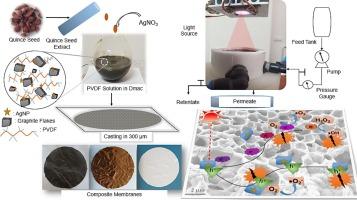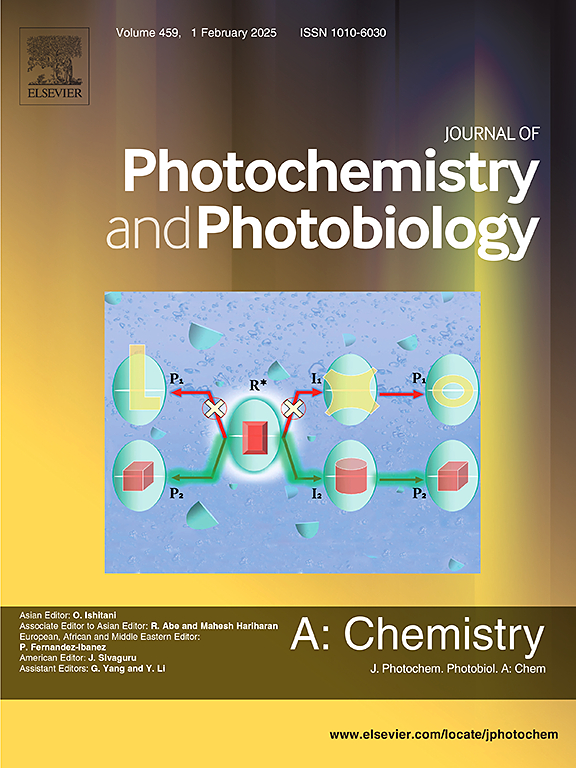Green synthesis of infrared controlled AgNP/graphite/polyvinylidene fluoride composite membranes for removal of organic pollutants
IF 4.1
3区 化学
Q2 CHEMISTRY, PHYSICAL
Journal of Photochemistry and Photobiology A-chemistry
Pub Date : 2024-11-14
DOI:10.1016/j.jphotochem.2024.116160
引用次数: 0
Abstract
The effectiveness of light-sensitive particle-added composites as alternative materials in the treatment of waste water was investigated. Infrared responsive polyvinylidene membranes were prepared with anchoring the graphite supported silver particles reduced by quince seed extract. X-ray diffractometer, scanning electron microscope and Fourier transform infrared spectroscopy analysis were used to characterize physicochemical and structural properties of composites. Photoluminescence, surface area and contact angle measurements were carried out. The filtration performances of the membranes were tested under infrared light in a continuous flow system. Methyl orange and bovine serum albumin solutions were used as model pollutants. The silver-graphite additive acted as light absorber and energy converter. Owing to the photothermal effect, the water flux, rejection and roughness of the AgNP-G-P membrane improved significantly, and those were recorded as 74.7 L.m−2.h−1.bar−1, 54.6 % and, 75.0, respectively (32.5, 22 and 74.1 %, respectively, for PVDF). The composites almost retained their initial performance after repeated use and did not cause solution leaching. In this study photothermal particles, which are frequently used in medical applications, were successfully adapted to the filtration system. It has the ability to add a specific and new dimension to the protection of the environment by purifying wastewater.

用于去除有机污染物的红外控制 AgNP/石墨/聚偏氟乙烯复合膜的绿色合成方法
研究人员调查了添加光敏颗粒的复合材料作为废水处理替代材料的有效性。制备了红外响应聚偏二乙烯膜,其中锚定了由榅桲籽提取物还原的石墨支撑银颗粒。利用 X 射线衍射仪、扫描电子显微镜和傅立叶变换红外光谱分析了复合材料的物理化学和结构特性。还进行了光致发光、表面积和接触角测量。在连续流动系统中,在红外光下测试了膜的过滤性能。甲基橙和牛血清白蛋白溶液被用作模型污染物。银石墨添加剂起到光吸收剂和能量转换器的作用。由于光热效应,AgNP-G-P 膜的水通量、排斥率和粗糙度显著提高,分别达到 74.7 L.m-2.h-1.bar-1、54.6% 和 75.0%(PVDF 分别为 32.5%、22% 和 74.1%)。这些复合材料在反复使用后几乎保持了最初的性能,并且不会造成溶液沥滤。在这项研究中,在医疗应用中经常使用的光热粒子被成功地应用到了过滤系统中。它有能力通过净化废水为环境保护增添一个特定的新维度。
本文章由计算机程序翻译,如有差异,请以英文原文为准。
求助全文
约1分钟内获得全文
求助全文
来源期刊
CiteScore
7.90
自引率
7.00%
发文量
580
审稿时长
48 days
期刊介绍:
JPPA publishes the results of fundamental studies on all aspects of chemical phenomena induced by interactions between light and molecules/matter of all kinds.
All systems capable of being described at the molecular or integrated multimolecular level are appropriate for the journal. This includes all molecular chemical species as well as biomolecular, supramolecular, polymer and other macromolecular systems, as well as solid state photochemistry. In addition, the journal publishes studies of semiconductor and other photoactive organic and inorganic materials, photocatalysis (organic, inorganic, supramolecular and superconductor).
The scope includes condensed and gas phase photochemistry, as well as synchrotron radiation chemistry. A broad range of processes and techniques in photochemistry are covered such as light induced energy, electron and proton transfer; nonlinear photochemical behavior; mechanistic investigation of photochemical reactions and identification of the products of photochemical reactions; quantum yield determinations and measurements of rate constants for primary and secondary photochemical processes; steady-state and time-resolved emission, ultrafast spectroscopic methods, single molecule spectroscopy, time resolved X-ray diffraction, luminescence microscopy, and scattering spectroscopy applied to photochemistry. Papers in emerging and applied areas such as luminescent sensors, electroluminescence, solar energy conversion, atmospheric photochemistry, environmental remediation, and related photocatalytic chemistry are also welcome.

 求助内容:
求助内容: 应助结果提醒方式:
应助结果提醒方式:


